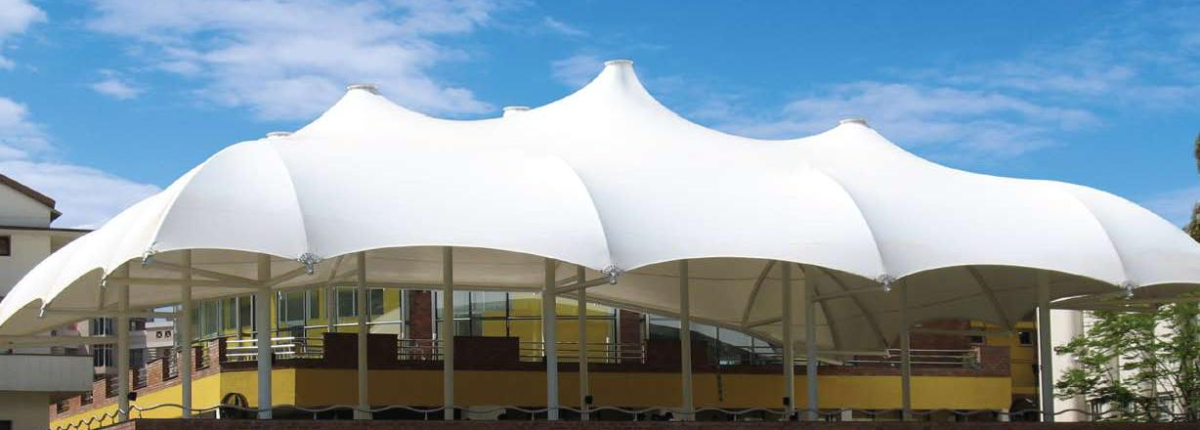Types of Tensile Fabric:
The fabric is everything, driving the way the structure looks, its authenticity, and strength. Archway Tensile is a manufacturer that uses high-quality coated fabrics:
PVC-Polyester (Polyvinyl Chloride): The most widely used and cheapest option. It is made using a polyester base fabric that is coated with PVC, and the top side features a coat of PVDF (Polyvinylidene Fluoride) with two types of finishes and an acrylic coat for weather protection, along with UV and self-cleaning characteristics. As it is vinyl, it can be flexible, come in a variety of colours, and has a life expectancy of around 15-20 years.
PTFE-Fiberglass (Polytetrafluoroethylene): Also known as Teflon®, PTFE-coated fiberglass delivers the “best of both worlds” – a non-stick surface designed for easy release and quick cleanup, even after repeated use. Its excellent chemical resistance, non-flammability, and 30-plus-year life mean FRP is very cost-effective over the life of the panel. It starts as an off-white colour and bleaches in natural sunlight to white. It is employed in large-scale permanent projects such as stadiums and airports where fire safety and longevity are essential.
ETFE (Ethylene Tetrafluoroethylene): This is not a woven fabric but a transparent fluorine-based plastic film. It is most commonly used in pneumatic pillows (layers of cushion filled with air). ETFE is very light, highly light-permeable, extremely robust (with a service life in excess of 30 years), and it is 100% recyclable. It creates dramatic, light-filled spaces.
HDPE (High-Density Polyethylene) Mesh: A woven mesh fabric used for shading applications such as umbrellas and building facades. It offers excellent shade, allows airflow, and reduces glare and heat gain.
The Whole Fabrication and Fixing Process: As a fabricator and manufacturer, Archway Tensile’s vertically integrated model offers complete control throughout the lifespan of your project.
Phase 1: Design and Engineering: The process always starts with a dream from a client. Archway’s in-house design team works closely with architects and engineers to develop concept schemes. Using the form-finding and analysis software outlined above, a structurally consistent 3D model is created. Upon approval, the model is converted into accurate 2D cut patterns for the fabric and detailed fabrication drawings for the steelwork.
Phase 2: Component Production: This stage takes place in two dedicated plants at the same time:
Fabric Cutting and Welding: The specific fabric chosen is laid on large cutting tables. The pattern is cut on a CNC (Computer Numerical Control) machine with less than 1% tolerance. These panels are joined together using high-frequency welding, resulting in seams even stronger than the material itself. It is this final membrane assembly that is formed.
MS Fabrication: The mild steel structural members (masts, columns, arches, and connecting nodes) are fabricated in their fabrication shop. Raw steel is cut, bent, and finished with the help of CNC plasma cutters, press brakes, and rollers. Parts are welded and then sent through a washing process to remove any impurities, followed by a black powder coating and hot-dip galvanization, resulting in a durable, corrosion-resistant finish.
Phase 3: Quality Assurance: Each part is also checked. An assessment of the strength and airtightness of fabric seams is conducted. Steel connections are reviewed for detail size and weld quality. This is essential for the safety of the building.
Phase 4: Erection / Tensioning: The pre-fabricated elements are delivered to the site. The process involves:
Steelwork Erection: The main support structure (masts/arches) and secondary components (edge cables, ridge cables, valley cables) are erected, aligned, and fixed in place.
Membrane Installation: The welded fabric membrane is loosely laid out and clamped onto the steel structure using purpose-designed clamping mechanisms.
Prestressing: This is the most important on-site activity. The fabric is then carefully stretched with tensioning devices to engineered specifications. Thus, the cloth is pulled from a limp condition into one that is very taut and presents a strong, stable surface. This must be done with skill and experience to ensure it is stressed and stretched evenly without over-stressing.
Phase 5: Handover: After the final checks and readings are completed, the structure is finished. Archway Tensile supplies maintenance documentation to ensure the long life and beauty of the system.
Archway Tensile represents the steps towards contemporary design and engineering. Their control of the whole workflow from form finding to material science to digital fabrication to expert installation enables them to expand the frontier of architectural possibilities. Tensile structures are membranes in their most natural state; no longer just covers, they have become iconic landmarks that are aesthetically exciting and, like biomimicry, embody what is best and most appropriate to our environment. With the ability to manage every stage of this advanced technology and the manufacturing process that comes with it, Archway Tensile plays a leading role in India’s futuristic approach to architecture.

